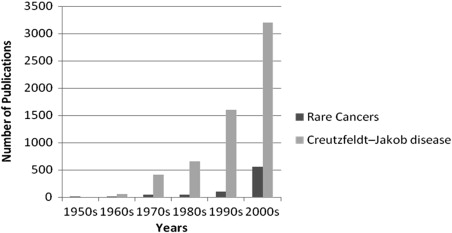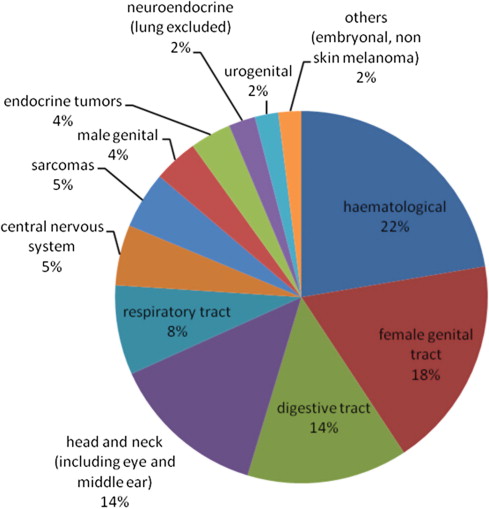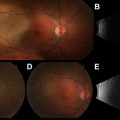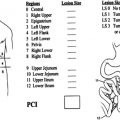Many rare cancers are essentially an enigma, with little to no information in the medical literature. Defining a rare cancer is not as easy as it might seem. As a guide, generally an incidence of fewer than 6/100,000 is considered rare. Much of the research regarding rare diseases is in its infancy.
Key Points
- •
Defining a rare cancer is not as easy as it might seem.
- •
As a guide, generally an incidence of fewer than 6/100,000 is considered rare.
- •
Much of the research regarding rare diseases is in its infancy.
Many rare cancers are essentially an enigma. For some there is little to no information in the medical literature. Based on a MEDLINE search (1950–2012) using the keyword “rare cancer” in the title, the first published literature occurs in 1953 with 2 articles on rare cancers, and over the years this progressively increases ( Fig. 1 ). While this increase is a good start, it is still a long way from what will be required to make substantial improvements in the treatment and quality of life for individuals with a rare cancer. On comparing this with other rare conditions, such as Creutzfeldt-Jakob disease (which affects 1 person in every million individuals), there are disparate differences in the number of publications, and this probably also correlates with levels of funding provided to research these conditions.

Definition of rare cancers
The Oxford English Dictionary defines “rare” as “of an event, situation, or condition not occurring very often.” Defining a rare cancer is not as easy as it might seem, and many organizations have used different definitions, whereas others have simply used definitions applied by other groups or organizations. The following provides examples of differing definitions of rare cancers.
RARECARE. This is the list of tumor entities from which rare tumors are identified as those with an incidence of fewer than 6 per 100,000 persons per year. The list presents the number of cases reported by European cancer registries during the period 1995 to 2002 and the corresponding incidence rates. Both figures are derived from the data of 70 population-based cancer registries adhering to the RARECARE project.
Rare Cancers Europe. Rare cancers are generally classified in the group of rare diseases, which is defined in the European Union as diseases with a prevalence of fewer than 5 cases out of a population of 10,000. According to this definition, rare cancers are identified as those with an incidence of fewer than 6 per 100,000 persons per year. Using this definition would help minimize the risk of mistaking a rare cancer (such as testicular cancer), which is frequently cured and thus has a rather high prevalence, for a common cancer, or a frequent cancer (such as small-cell lung cancer), which has a low life expectancy and thus a low prevalence, for a rare cancer.
Office of Rare Diseases. A rare (or orphan) disease is generally considered to have a prevalence of fewer than 200,000 affected individuals in the United States. The Office of Rare Diseases provides a searchable list of almost 7000 rare diseases with links to information from federally supported databases and information sources. The Rare Disease Act of 2002 (HR 4013) and the US Orphan Drug Act define a rare disease or condition as one that “(A) affects fewer than 200,000 persons in the United States, or (B) affects more than 200,000 in the United States and for which there is no reasonable expectation that the cost of developing and making available in the United States a drug for such disease or condition will be recovered from sales in the United States of such drug.” Statistically speaking, with a population of 287,400,000, this means roughly 0.07% of the United States population.
The European Commission on Public Health defines rare diseases as “life-threatening or chronically debilitating diseases which are of such low prevalence that special combined efforts are needed to address them. As a guide, low prevalence is taken as prevalence of fewer than 5 per 10,000 in the Community.” This would calculate into 0.05% of the overall population.
Rare Cancers US. The definition of “rare” was adopted from a recent National Cancer Institute–sponsored cancer epidemiology workshop: an incidence of fewer than 150 per million per year (ie, 15 per 100,000 per year), roughly corresponding in the United States to 40,000 new cases per year or fewer.
European Action Against Rare Cancers. Rare is defined as fewer than 50 out of 100,000 cases per year.
These are just some of the definitions of rare cancers, and the approximate number per 100,000 to be considered rare is less than 6. However, these are just numbers and like common cancers some attract more media attention, more funding, and more researchers than others. Based on the definition of 6/100,000 cases, Rare Cancers Europe has developed a list of 186 rare cancers ( Fig. 2 ). It should be remembered that the study of rare cancers is not limited to rare histologic variants, but also includes subgroups that can be difficult to study in common cancers (eg, T4N0 breast cancer). Conversely, rare cancers can be rare episodes of common cancers that present in uncommon hosts (eg, male breast cancer).









